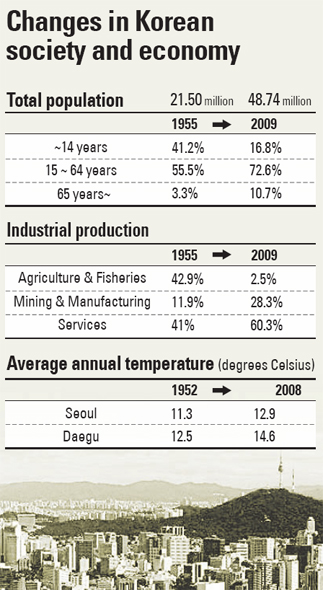Statistics highlight scale of the aging population

During the same period, the average number of students each schoolteacher had to teach at one time also shrunk, from 58.9 to 19.8, and farming industry production, which accounted for nearly half the nation’s entire economic production, shrank to less than 3 percent.
These are examples of the dramatically altered landscapes in the Korean economy, culture and society, based on figures from the government statistics agency that tallied key information from 1952 until today. Statistics Korea, the state statistics agency formerly known as the National Statistical Office, published the Korea Statistics Almanac yesterday.
The database has more than 1,000 statistics entries, ranging from population, public health and education to economics.
Above all, the compiled data highlights the nation’s rapidly aging society. Back in 1955, people aged over 65 accounted for only 3.3 percent of the total population, but now the presence of such senior citizens accounts for 10.7 percent of the whole population.
During the same period, the figure for those aged 15 to 64, considered the “economically active age,” climbed from 55.5 percent to 72.5 percent, while the nation’s entire population has increased from 21.5 million to 48.75 million.
In 1955, most school classrooms were crowded with more than 50 students, as Korean parents were eager to provide children with a good education at all costs even amid devastating poverty during the postwar period.
Back then, the average number of students for each schoolteacher was 58.9. But the number has declined to 19.8 as of this year, a remarkable improvement caused not only by efforts to improve education infrastructure but also by the ever-shrinking birthrate.
The data also highlights the dramatic change in the nation’s economic landscape. Production in the agriculture and fisheries industries, which accounted for 45 percent of the whole economic population here in 1953, is now seeing its presence shrink to less than 3 percent. During the same period, the number for mining and manufacturing production jumped from 10 percent to more than 28 percent.
The database also showed fatalities during the Korean War, saying 990,000 Koreans were killed during the three-year war.
By Jung Ha-won [hawon@joongang.co.kr]










with the Korea JoongAng Daily
To write comments, please log in to one of the accounts.
Standards Board Policy (0/250자)